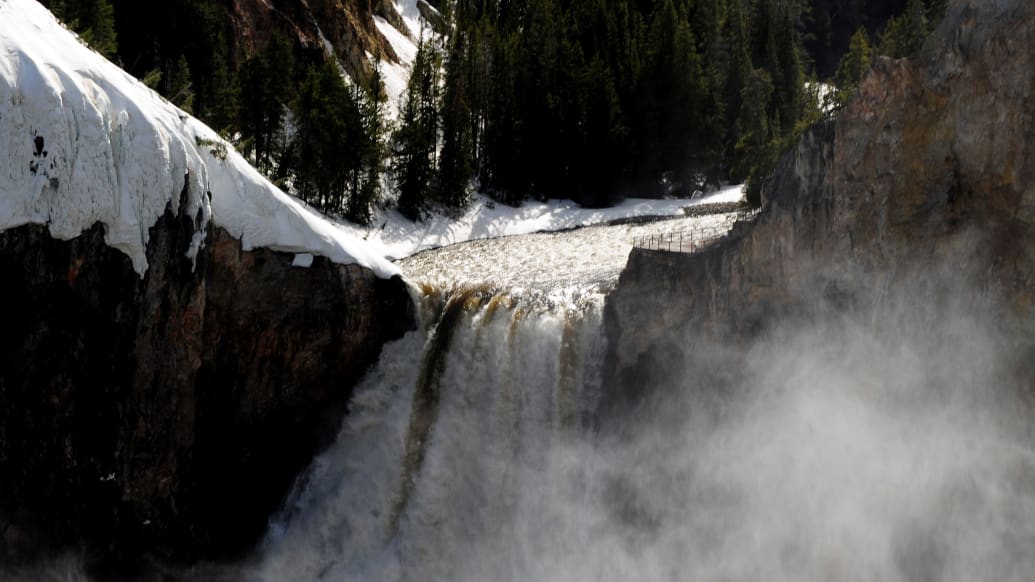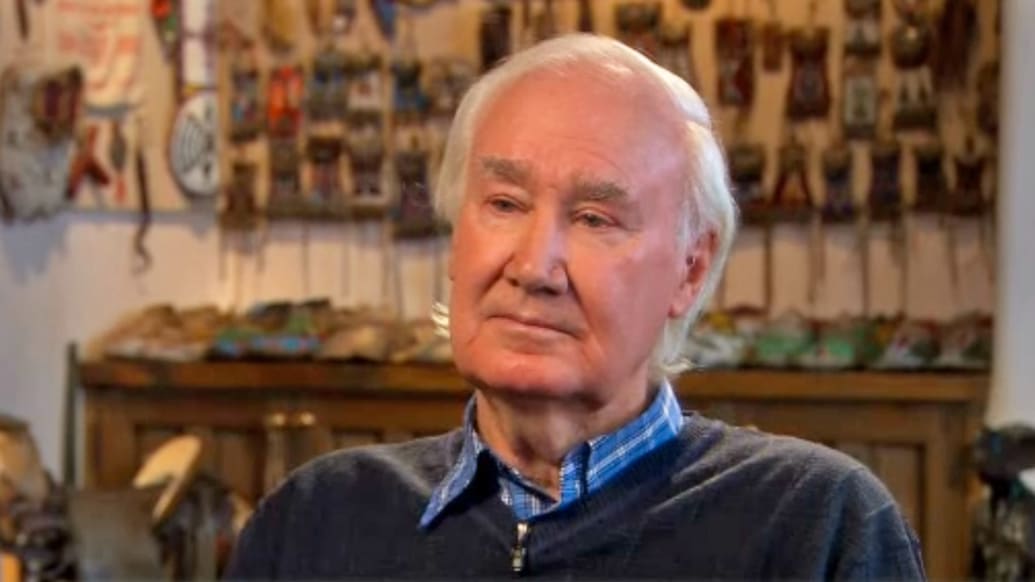what route did fenn take to west yellowstone
This was the big moment for me, when I realized Forrest Fenn had the requisite crazy, that immortality was on his saucepan list—peradventure was his entire bucket list—and that he would cease at zip to shove himself into history. I was standing in his domicile role on my first 24-hour interval in Santa Fe, New United mexican states, working on a contour of him. The room was wall-to-wall artifacts. Moccasins and headdresses. Dolls and skulls. At least one buffalo head had an arrow tip still lodged in it. And amid the lost-world splendor of it all, sitting on Fenn's desk was a quart-size bronze bell.

Fenn buries them, he told me, each one stuffed with his life story, stamped with his name, and—lest at that place be any confusion at all almost their purpose—engraved with messages for posterity: "It doesn't matter who you are, it only matters who they think you are"; "If you should e'er think of me, a thousand years from at present, delight band my bell so I will know"; "God volition forgive me, that's what he does."
Faced with the prospect of condign clay himself, "the leftovers of history," every bit he writes in The Thrill of the Chase, he decided he'd effort to brand certain that in the smashing Google search of eternity, he e'er has a place. One plan to do and so was the bronze bells. The other, of course, was the treasure.
I believe yous can detect it, even if you skip nearly the entire 2d half of The Thrill of the Chase. You can ignore every page almost Fenn's war years, his gallery years, and his budding family. Uncap your highlighter, however, when you lot run across the word "Yellowstone" or "father," or "cancer." These words marker important passages, the best windows into Fenn's mind as he equanimous the work—and picked his spot.
Yellowstone National Park is my odds-on favorite to hold the treasure, based on the documents Fenn has given me, materials not in The Thrill of the Hunt. Fenn spent at to the lowest degree twenty summers there, and in The Thrill of the Chase he says, "I absolutely loved that place." In the book, however, Fenn doesn't say much about specific locations in the park where he spent his Huck Finn years, let alone reveal details that might stand for with the hints in his now-famous poem. He seems to have blurred the image just so.
But Fenn sent me some unpublished work that isn't and then carefully presented. "Ramblings and Rumblings: The Fenn Family unit History (unedited)" was begun in the summer of 1996, with pencil scribblings in a blue notebook, and expanded haphazardly for years. "Information technology is simply notes and thinkings," Fenn writes by way of preface. He compiled it for his grand kids, because he wished his own dad had washed the aforementioned for him.
Yellowstone is the star of this Fenn history, even more then than information technology is in The Thrill of the Chase. It's just the kind of identify a sentimental fellow might render to carve his place in history. It'southward "where my heart is," Fenn writes in "Ramblings and Rumblings." His parents returned every summer of their lives, his mother dying in a trailer park near Cameron, Montana, just due north of the park, where the west fork of the Madison River runs into the Lower Madison River.
Fenn'south father died in Texas (and more than on this to come up), but in the old human being'south final summertime alive, his son made sure he saw Yellowstone. Fenn drove his male parent, pulling an Airstream trailer 1,700 miles one way, to where the Fenn family unit fished and camped until every child was grown.
When Fenn was in grade-schoolhouse, co-ordinate to the manuscript he prepared for his kids, his family unit camped well-nigh the Fishing Bridge, which crosses the Yellowstone River as information technology exits Yellowstone Lake. This may shed light on ane of the lines in Fenn'south poem, which reads: "Put in below the habitation of brown," a line many people interpret to exist dark-brown bears, a.k.a. grizzlies. Notably, and so, Fenn's ramblings include this: "At night the bears were a problem … and while the black bears were not a wellness threat, the Grizzlies killed several people every summer."
Later the family moved from the Fishing Bridge to a campsite in West Yellowstone, which has its own special resonance for treasure seekers. In "Ramblings and Rumblings," Fenn describes "a secret location" where the family gear was stashed during the off-flavor. "We just drove the motorcar out into the woods about half a mile, and unloaded everything," Fenn writes—and it was always there when they returned.
No matter where they were, the Fenns were line-fishing, and their favorite locales—disclosed in the unpublished family unit history—have promise too. The Madison River's all-time spots to cast a line: "the Tedious Curve (five miles up), the Nine Mile Pigsty (y'all guessed it, nine miles), and the Water Hole (most xi miles)." The parentheses are all Fenn, as are the ALL CAPS, when he writes that these spots were "Height SECRET," specially Nine Mile Hole, considering it could concur just one fisherman. Perhaps that'south a lucifer to the opening line of Fenn'southward treasure poem, "As I have gone alone in there."

Simply as you frisk and refrisk the verse form for its significant, go on a few more clues in mind: some people have suggested the treasure is nether water, plopped in a river where Fenn loved to fish or swim. They are wrong, I know, for in a moment of exuberance, Fenn said so. He told me the chest is "exposed" to rain and snowfall, and could be scorched in a forest fire. He told me the box, which is just 10 inches past 10 inches, is unlocked—suggesting it's someplace where it is unlikely to be toppled or otherwise thrown open up.
Most importantly, when you're scouting locations, consider that Fenn originally needed a infinite big enough to fit his own trunk. That'due south because he planned to entomb himself alongside the box, and he notwithstanding might. How serious is the idea? An earlier draft of the poem ended, "And then take the chest and leave my bones."
Fenn has rewritten the verse form, but he may but stop upward entombed with his treasure yet. "If I am diagnosed with terminal annihilation," Fenn told me, "I will non die in a infirmary bed if I take a few breaths remaining. I don't want to give any more clues, simply if I am non too feeble to return to the chest when my plow comes, I cannot think of whatever better place for my bones to rest for a few millennia."
In that location's always the adventure I'one thousand wrong about Yellowstone. If so, my 2nd pick would be northern Arizona, another place that Fenn has explored intensively, start when he trained pilots at Luke Air Strength Base in the early on '60s. "I started exploring ruins a lot and digging," he writes in "Ramblings and Rumblings," his unpublished family history. "It was a fun fourth dimension." He glosses over that period in The Thrill of the Chase, but his Arizona stories are well known to friends.
Douglas Preston, who has covered archeology for The New Yorker, remembers Fenn telling him daring stories of flight through canyons, looking for alcoves and stone shelters that can't be seen from above or below. "He would find them but as they were left when the Indians walked out," Preston told me. 1 fourth dimension he establish a pot cleaved beneath a wooden peg, where it had hung ready for use. Another time he constitute—and notwithstanding has, Preston says—a pot that had been repaired with a little beloved and yucca cobweb.
Information technology's Fenn's Arizona stories, in fact, that got him—and keep him—in trouble with the federal authorities. At least twice in 2008, an informant posing every bit an artifact collector and outfitted with a wire and hidden camera, visited Fenn, who entertained the invitee with tales of his exploits.
He loves ducking into caves in particular, which seem a space to match Fenn's ambitions, having long been used by people for tombs, shrines, and long-term storage. Again and again in his recorded conversations with law enforcement, Fenn mentions "caves" and "cave material," and ancient artifacts he found "out of a cave." He went into so many caves, he told the informant, he caught an infection from the dusty air.
The only other identify the treasure may logically exist is in northern New Mexico, not far from where Fenn lives today. Dominion out Colorado and Nevada, as well as Idaho and Utah, which each get a demerit because they're known for bait angling, not fly-angling, and Fenn is loyal to the latter. Remember that "blaze" is in the treasure verse form because Fenn hoped to throw people off at that juncture. "I was careful," he told me. "A blaze can be on a tree, in a burn, on the face up of a horse, and a host of others."
But no matter what state yous look in, think big and significant places. Fenn is sentimental, sure, simply he's also got the ego of the fighter jock he once was, a guy who believes traffic lights are "antagonistic to freedom" and that in that location's no police force or celebrated parcel he wouldn't traverse for the sake of immortality. Go on the questions coming in the comments department; I'll keep answering.
For now, the last words should be Fenn's, the most poetic thing he said to me, and a sensi-like motivational koan for treasure hunters about to hit the trail: "Life adventures are like thunderstorms. It gets nighttime, the wind blows, everyone runs for cover. A few people get wet … then information technology's gone, until the next one. And the survivors are those with the biggest umbrella."
jordansubjectence.blogspot.com
Source: https://www.thedailybeast.com/clues-for-finding-forrest-fenns-buried-treasure-part-2
0 Response to "what route did fenn take to west yellowstone"
Post a Comment